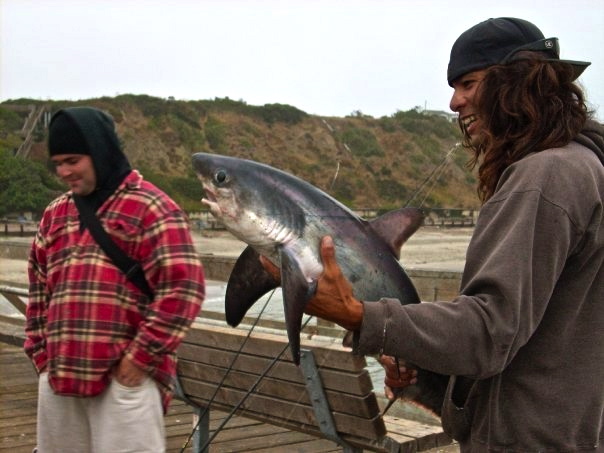Order Lamniformes — Thresher Sharks—Family Alopiidae
Small thresher shark from the Pacifica Pier in 2006
Species: Alopias vulpinus (Bonnaterre, 1788); from the Greek word alopos and Latin word vulpes, (both meaning fox).
Alternate Names: Thresher, blue thresher, longtail shark, swiveltail, fox shark, sea fox, fish shark, sea ope, pesca pavone. A worldwide range with a worldwide list of foreign names—pez zorro (Spanish), cação-pena (Portuguese), faux (French), fuchshai (German), aleposkylos (Greek), big-eye thresher (English), budenb (Maltese), cacao-raposa (Portuguese), chichi espada (Spanish), coleto (Spanish), coludo (Spanish), coludo pinto (Spanish), drescherhai (German), grayfish (English), grillo (Spanish), guadaña (Spanish), guilla (Catalan), jarjur (Arabic), kalb (Arabic), karage (Swahili), kettuhai (Finnish), Kosogon (Polish), K’wet’thenéchte (Salish), Langschweif (German), Loup de mer (French), mango-ripi (Maori), ma’o aero (Tahitian), mao-naga (Japanese), papa kinengo (Swahili), pas lisica (Serbian), pating (Tagalog), pèis rato (French), peixe-rato (Portuguese), peje sable (Spanish), peje zorra (Spanish), pejerrabo (Spanish), pesce volpe (Italian), peshkdhelpën (Albanian), pez espada (Spanish), pez palo (Spanish), pichirata (Spanish), pixxivolpi (Maltese), poisson-épée (French), psina lisica (Serbian), qatwa al bahar (Arabic), rabilongo (Portuguese), rabo de zorra (Spanish), rævehaj (Danish), raposa (Spanish), raposa marina (Spanish), raposo (Portuguese), rävhaj (Swedish), rechin-vulpe (Rumanian), renard (French), renard de mers (Creole), renard marin (French), requin renard (French), revaháur (Faroese), revehai (Norwegian), romano (Portuguese), romão (Portuguese), sapan (Turkish), sapan baligi (Turkish), seefuchs (German), singe de mer (French), skylópsaro (Greek), squalo volpe (Italian), tærsker (Danish), te bakoa (Kiribati), te kimoa (Kiribati), thon blanc (French), tiburón zorro (Spanish), tubarão raposo (Portuguese), volpe de mar (Italian), voshaai (Dutch), watwa albahar (Arabic), whip-tailed shark (English), zoro cauda longa (Portuguese), zorro (Spanish), and zorro blanco (Spanish).
Thresher taken from the Half Moon Bay Jetty in 2009
Identification: Easily identified by the long tail (caudal fin) that is as long as the rest of the body. The only other similar shark in California water is the rare, deep-water, big-eye thresher. Their coloring is brown to bluish gray to black to purplish on the back shading to white below. Their overall shape is spindle-shaped with two dorsal fins, a tiny anal fin, and curved pectoral fins. They have a short snout with a mouth full of small but sharp teeth.
Size: To 18 feet and possibly 25 feet. Most caught from piers are youngsters (practically babies) under 6 feet in length. The California record fish was a 575 lb 0 oz fish caught off Carlsbad Canyon in 2007.
Range: Circumglobal in warm waters. In the eastern Pacific from Chile to southeastern Alaska, and Goose Bay, British Columbia. Most threshers caught in California are taken south of Point Conception.
 A thresher taken by red805 at the Goleta Pier in 2015
A thresher taken by red805 at the Goleta Pier in 2015
Habitat: Most common in deeper offshore water but young threshers venture into shallower water. A number are caught by southern and central California pier rats every year.
Piers: Most common on oceanfront piers south of Point Conception although some are taken every year from Central Coast piers. Best bets: Ocean Beach Pier, Oceanside Pier, San Clemente Pier, Balboa Pier, Newport Pier, Huntington Beach Pier, Redondo Beach Pier, Hermosa Beach Pier, Venice Pier, Santa Monica Pier, Malibu Pier, Ventura Pier, Gaviota Pier, and Pismo Beach Pier. The Gaviota Pier may be the best pier in the state for threshers (and some feel the nearby waters are a “pupping” area) but the pier is currently closed and no one seems to know when or if the state will reopen it?
 A thresher taken by Wayne at the Cayucos Pier in 1997
A thresher taken by Wayne at the Cayucos Pier in 1997
Shoreline:Rarely caught from shore unless near deepwater areas.
Boats: A major species for both boaters and kayakers in southern and central California. Live bait is preferred but they aren’t easy to land from a kayak.
Bait and Tackle: Bony fish make up 97% of the thresher’s diet. Mostly these are small, schooling species such as mackerel, jack mackerel and sardines. As a result, the recommended bait is a live whole fish with mackerel and sardines leading the list. A whole squid also makes excellent bait. Anglers specifically fishing for them land the great majority of threshers. Tackle should be heavy and include a net to bring the fish onto the pier. Line should be at least 40-pound test, a wire leader is preferred and hooks can be 4/0 or larger.
Thresher taken at the Ventura Pier in 2010
Food: An excellent, mild flavored flesh! Threshers can be prepared many ways but one of the best is to simply cut the meat into steaks and broil them on a grill. The meat does need to be cleaned properly and kept cool before cooking.
Comments: The high demand for thresher steaks, accompanying high prices, over-fishing, and low number of pups birthed each year by females (two to four), have led to a dramatic drop in the thresher population in the last twenty years. Many people feel there should be either a ban or severe limits imposed on the take of threshers.
Thresher — Seacliff State Beach Pier in 2009



















